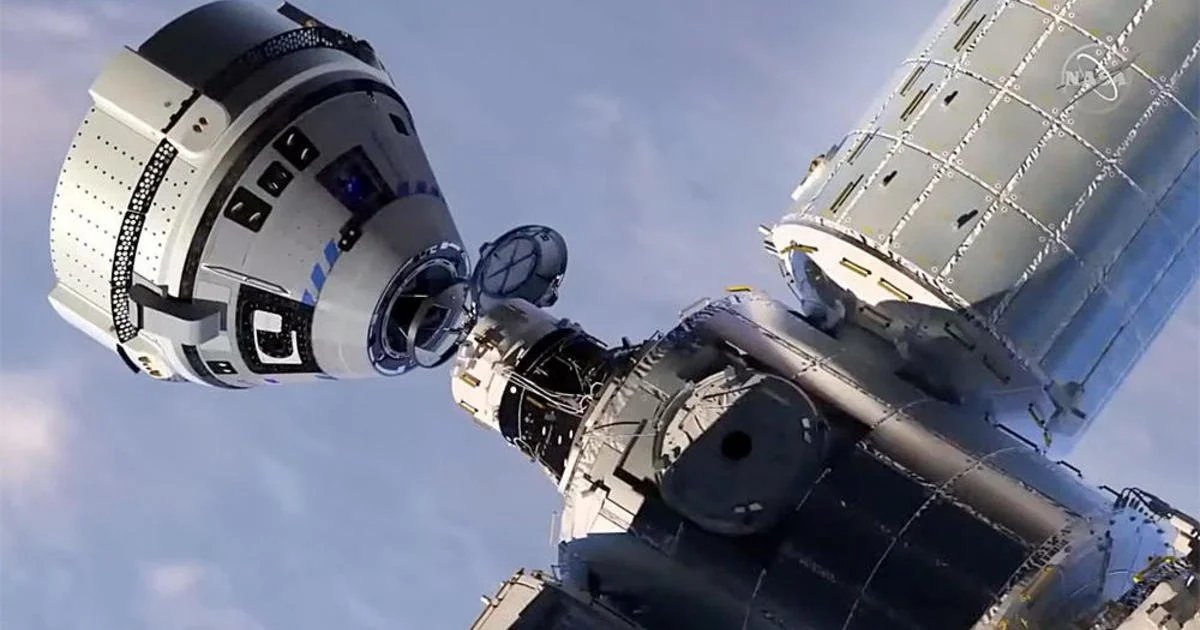Well Starliner finally made it, the long delayed Boeing space capsule has at last succeeded in taking live astronauts to the International Space Station (ISS). Problem is it hasn’t succeeded in returning them safely to Earth yet. Launched from the Kennedy Space Center on June 5 aboard an Atlas V rocket the Starliner Crew Flight Test (CFT) managed to dock with the ISS the next day and the two person crew of NASA astronauts Butch Wilmore and Suni Williams were welcomed by the official crew of the ISS. The launch itself was delayed several times because of faulty valves and leaks in both Starliner and the Atlas V rocket.

In fact launch was only allowed to go ahead after NASA decided that a helium leak in Starliner did not threaten the mission. Then, during the daylong trip in Low Earth Orbit (LOE) to the ISS Starliner developed another four helium leaks. Finally, as the spacecraft neared the ISS yet another technical issue appeared as five of Starliner’s twenty-eight maneuvering thrusters began to function erratically forcing a two hour delay in docking.

Because of all those problems NASA decided to delay Starliner’s return, rather than remaining at the ISS for about a week Butch Wilmore and Suni Williams have now spend more than a month at the ISS trying to resolve Starliner’s problems, or at least learn more about them. Officially NASA says that the two astronauts are not ‘stranded’ in space but this situation is certainly without precedent.

The two astronauts are in no danger; they are perfectly safe at the ISS, they could always be brought back down in a Space X Dragon capsule. If after all of the testing in orbit however NASA finally does decide that Starliner isn’t reliable enough to bring Wilmore and Williams back to Earth it would be a terrible blow to Boeing’s Starliner program, and Boeing itself.

So Starliner still has problems, but are they serious enough to cause NASA to refuse to certify the capsule for regular operation in the Commercial Crew Program. NASA does not like the idea of entrusting its astronauts to vehicles that have any technical problems, and Starliner obviously still has quite a few. The space agency could require Boeing to conduct one more CFT in the same way that it required Boeing to conduct a second unmanned Orbital Flight Test (OFT) of Starliner back in December of 2019. That decision will undoubtedly have to wait for the final mission review.

However NASA has been waiting a long time for Starliner to begin conducting regular crew rotation missions to the ISS as a part of the Commercial Crew program. In fact at the beginning of the Commercial Crew Program it was expected that Boeing would contribute the largest part of the missions to the ISS under the program. That’s why the Aerospace giant received the largest development contract, $4.2 Billion USD, while Space X received only $2.6 billion to develop their Dragon capsule. Originally NASA’s schedule called for Starliner to carry out its test flights back in 2017 and begin regular missions to the ISS in 2018, to be followed shortly thereafter by Space X’s Dragon capsule.

What eventually happened however was that Space X, after a few delays carried out its first regular mission, designated as Crew-1 in November of 2020 and has now successfully conducted nine missions as a part of the Commercial Crew Program. Space X is now contracted to conduct another 14 crew transfer missions before the ISS is officially shut down and de-orbited. The price tag for the remaining 14 Space X missions is set at $258.7 million each or $64.4 million per seat.

Currently NASA still hopes that Boeing’s Starliner can also participate in regular crew rotation missions to the ISS. Assuming that Starliner does receive certification Starliner’s first crew mission is scheduled for no earlier than 2025 and NASA has contacted Boeing to provide a total of six regular crew missions by 2030. The estimated price tag for a seat on Starliner is approximately $95 million per seat or around $380 million per mission.

Even at that price however Boeing is not going to make money on Starliner from the Commercial Crew Program. The added cost of seven years of delays, the extra unmanned OFT and the possibility of NASA requiring a second CFT will certainly cause Boeing to suffer a financial loss. However Boeing is looking beyond this decade to the 2030’s when it is expected that several privately owned space stations will be in orbit and the business of taking astronauts, scientists and even tourists to those stations will become much more profitable. Boeing had better fix its capsules remaining problems though; it already has competition in Space X’s Dragon and Sierra Nevada’s Dreamchaser mini-shuttle is scheduled to make it’s first, unmanned flight later this year.

Before I go I just want to mention some good news concerning everybody’s favourite space probe that could, Voyager 1. You’ll recall that back in November the Voyager probe began radioing back a data stream that made no sense to the Voyager team at the Jet Propulsion Labouratory (JPL). See my post of 9 September 2023. Well after a lot of effort on the part of the engineers at JPL in April they managed to correct the problem to the extent that Voyager was back in communication with Earth.

Even with that success however, there was still a considerable amount of work to be done before the probe was fully repaired. Now, on June 14th NASA announced that Voyager 1 is fully functional and sending back useful measurements about the void of interstellar space which it was the first of all human made objects to ever reach.
